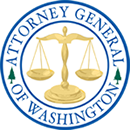First-of-its-kind suit alleges nearly 2 million Consumer Protection Act violations; seeks refunds for more than 400,000 Washingtonians
SEATTLE — Attorney General Bob Ferguson filed a lawsuit today against cable television and Internet giant Comcast Corporation in King County Superior Court, alleging the company’s own documents reveal a pattern of illegally deceiving their customers to pad their bottom line by tens of millions of dollars.
The lawsuit accuses the company of more than 1.8 million violations of Washington state’s Consumer Protection Act (CPA), including misrepresenting the scope of its Service Protection Plan, charging customers improper service call fees and improper credit screening practices.
The lawsuit also accuses Comcast of violating the CPA to all of its nearly 1.2 million Washington subscribers due to its deceptive “Comcast Guarantee.”
The lawsuit is the first of its kind in the nation — though the Service Protection Plan is a nationwide program and many of the improper practices are used in all of Comcast’s markets. The Attorney General’s Office brought these issues to Comcast over a year ago, but the company didn’t begin to make changes until recently — on the verge of this litigation.
“This case is a classic example of a big corporation deceiving its customers for financial gain,” Ferguson said. “I won’t allow Comcast to continue to put profits above customers — and the law.”
Misleading Service Protection Plan
The AGO lawsuit accuses Comcast of misleading 500,000 Washington consumers and deceiving them into paying at least $73 million in subscription fees over the last five years for a near-worthless “protection plan” without disclosing its significant limitations. Customers who sign up for Comcast’s Service Protection Plan pay a $4.99 monthly fee ostensibly to avoid being charged if a Comcast technician visits their home to fix an issue covered by the plan.
Comcast routinely claimed that the “comprehensive” plan covered the cost of all service calls, including those related to inside wiring, customer-owned equipment connected to Comcast services and on-site education about products. However, Comcast did not appropriately disclose that the plan does not cover repairs to any “wall-fished” wiring — wiring inside a wall — which constitutes the vast majority of wiring inside homes.
As part of the AGO investigation, customers contacted Comcast multiple times. Seventy-five percent of the time, Comcast representatives told these customers the plan covered all inside wiring. That isn’t true.
Customer service scripts, obtained during the investigation, direct Comcast’s representatives to state that the plan covers service calls “related to inside wiring” or “wiring inside your home.” The plan does not, in fact, cover the vast majority of inside wiring.
The AGO investigation uncovered that Comcast misrepresents the limitations of several other elements of the plan, including its coverage of service calls related to consumer-owned equipment and the repair of cable jumpers, connectors and splitters.
While Comcast claims that these restrictions are in the plan’s terms and conditions, Comcast does not provide those terms and conditions to its customers, does not require customers to approve them nor do they tell customers that these additional terms and conditions exist. A customer must proactively search Comcast’s website to find these terms and conditions.
Improper service fees
The AGO lawsuit also accuses Comcast of charging fees to many non-Service Protection Plan subscribers for services that should have been free.
Comcast deceives consumers through the Customer Guarantee it makes to all 1.2 million Washington customers. Comcast’s Customer Guarantee promises: “We won’t charge you for a service visit that results from a Comcast equipment or network problem.” Comcast discloses no limitations on this guarantee.
Contrary to this promise, Comcast charged thousands of Washington customers for service calls that resulted from a Comcast equipment or network problem, including issues with Comcast HDMI and component cables, Comcast cable cards, and the installation of drop amplifiers, which fix Comcast signal problems.
In addition, until approximately June 2015, Comcast provided its technicians with a service call fix code that expressly allowed them “to add service charges to a normally not charged fix code.” In other words, the company created a code for technicians to add charges to a service call that should be provided at no cost.
Improper credit checks
The AGO investigation uncovered thousands of instances of improper credit screening by Comcast, unnecessarily impacting the credit reports of those customers.
Comcast requires a deposit for equipment, but that deposit can be waived if a credit check reveals a high credit score.
On more than 6,000 occasions, however, Washington state consumers paid a deposit to Comcast, despite credit checks performed by the company revealing the customers had high credit scores. This indicates that the either: (a) customers paid the deposit to avoid a credit check appearing on their credit report, only to have Comcast run one anyway; or (b) customers were forced to pay the deposit despite their high credit score, contrary to Comcast’s policy.
For its CPA violations, the Attorney General’s Office is seeking:
- More than $73 million in restitution to pay back Service Protection Plan subscriber payments;
- Full restitution for all service calls that applied an improper resolution code, estimated to be at least $1 million;
- Removing improper credit checks from the credit reports of more than 6,000 customers;
- Up to $2,000 per violation of the Consumer Protection Act; and
- Broad injunctive relief, including requiring Comcast to clearly disclose the limitations of its Service Protection Plan in advertising and through its representatives, correct improper service codes that should not be chargeable and implement a compliance procedure for improper customer credit checks.
-30-
The Office of the Attorney General is the chief legal office for the state of Washington with attorneys and staff in 27 divisions across the state providing legal services to roughly 200 state agencies, boards and commissions. Visit www.atg.wa.gov to learn more.
Contacts:
Peter Lavallee, Communications Director, (360) 586-0725; PeterL@atg.wa.gov

 Other Languages
Other Languages